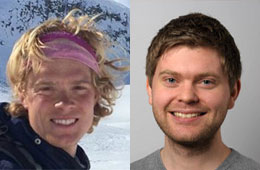Nature Communications article from OCBE: Inequality in genetic cancer risk: Bad genes or bad luck?

Which factors increase the risk of cancer? What is the relative importance of heritable factors, the environment and randomness? Such questions often lead to discussions and speculations, which unfortunately tend to be imprecise. In a recent publication in Nature Communications, researchers Mats J. Stensrud and Morten Valberg from Oslo Centre for Biostatistics and Epidemiology (OCBE) use statistical methods to quantify the distribution of genetic cancer risk in a population. Their results show that genes have a major influence on the risk of cancer. For 15 common cancers, the inequality in genetic cancer risk is larger than the inequality in income in the USA.
There is an ongoing intense debate about the causes of cancer, in particular the role of randomness. This debate was sparked by a Science paper by Tomasetti & Vogelstein (T&V) in 2015, which was followed-up by another Science paper in March 2017. Their work received massive attention, and lead to headlines in media such as The New York Times, The Guardian and Norwegian newspaper Dagbladet. The interpretation of T&V’s results has been that the majority of cancers are due to completely random mutations occurring during stem cell division. That is, they are due to ‘bad luck.’ The implication is that the majority of cancers cannot be prevented (!).
The study of Stensrud and Valberg enters into the heart of this debate, and sheds light on the results by T&V. They studied 15 types of cancer, and found that the genetic risk varies substantially between individuals. Some individuals got a large risk, whereas others got a small risk. Results from twin studies are used to show that there are heritable (genetic) factors that lead to major inequalities in the cancer risk between individuals. These genes are not necessarily known, but there is reason to claim that these factors exist. Hence, trying to identify genetic variants that increase cancer risk should remain an important target for future research. If we can identify these variants, we may impose preventive interventions that could reduce the incidence of these cancers.
In economics, the Gini index is often used to measure the inequality in income or wealth in a country. This index is a number between 0 and 1. When the Gini index is equal to 1, there is “total inequality” (one person earns all the money in the country). If the Gini index is 0, there is perfect equality (every individual earns the same amount). The Gini index for the distribution of income in the USA is 0.41, according to the World Bank, while it is 0.27 for Norway. These numbers confirm the common intuition that the inequality in income in the USA is relatively large. We may also use the Gini index to quantify the inequality in genetic cancer risk rather than income. If this Gini index is small, genes do not matter much for the risk of disease. If the Gini index is large, genes have a big influence on cancer risk. Stensrud and Valberg calculated the Gini index for the genetic risk of 15 cancers, and found that the Gini indices for all of these cancers were large. In fact, they were all larger than the Gini index for the income distribution in the USA. That is, the genetic risk distributions of these cancers are more skewed than the income distribution in the USA!
Based on the results by Stensrud and Valberg, it is possible to make crude calculations on the effect of hypothetical interventions. For example, suppose we were able to identify the 20% of the population with the highest genetic risk of prostate cancer, and we could reduce the risk in these subjects to the mean risk in the 20% at lowest genetic risk. Then, Stensrud and Valberg predict that the number of prostate cancers would be reduced by about 70%.
Given the large inequalities in the genetic risk of the 15 cancers, it is very unlikely that ‘bad luck’ is responsible for the majority of cancers. This also gives a more positive outlook for the future: If we are able to identify the individuals at highest genetic risk, we might develop interventions to prevent such cancers. On the other hand, if ‘bad luck’ was a major component in cancer development, the majority of cancers may be unavoidable.
OCBE is a joint center integrating the activities of the Department of Biostatistics, UiO and the Section of Biostatistics, Epidemiology and Health Economics, OUS.
Links:
The article:
Inequality in genetic cancer risk suggests bad genes rather than bad luck.
Stensrud MJ, Valberg M.
Nat Commun. 2017 Oct 27;8(1):1165. doi: 10.1038/s41467-017-01284-y.
PMID:29079851
Oslo Centre for Biostatistics and Epidemiology (OUS)
